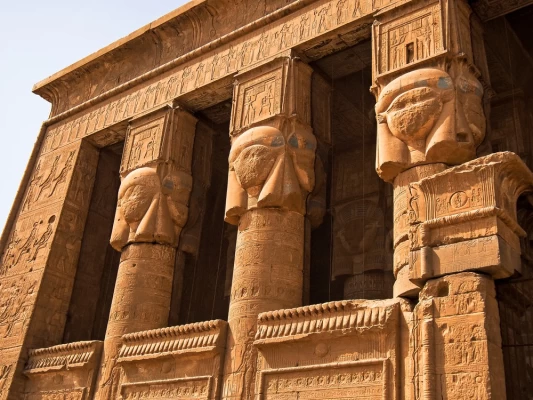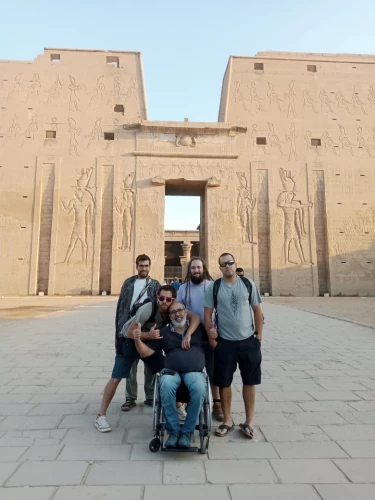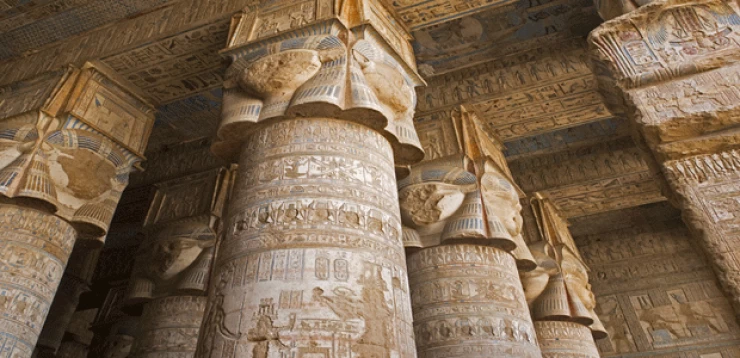
Temple of Dendera
The Temple of Dendera: A Timeless Marvel of Ancient Egypt
Situated on the western Nile edge near modern Qena in Upper Egypt is the superbly preserved Temple of Dendera.
The Ptolemaic era architectural development at Dendera manifests through thousands of years of religious devotion while honouring Hathor as its principal goddess. The Temple of Dendera stands as exceptional proof of ancient Egyptian civilization through its detailed carved elements and celestial consolidated crypts.
The Temple of Dendera serves as remarkable evidence of ancient Egyptian civilization because of its intricate carvings and astronomical ceiling and interlocking crypts.
Historical Background
Since the Old Kingdom period around 2600 BCE, the Dendera Temple complex has existed within a site that has maintained continuous religious usage. However, most of the structures visible today date back to the Greco-Roman era, particularly the Ptolemaic dynasty (305–30 BCE) and the early Roman emperors.
King Ptolemy XII initiated construction activities at Dendera Temple, which later Roman emperors, including Augustus, Tiberius, and Nero, completed during the father-son reign from 80–58 BCE and 55–51 BCE. The mixture of Egyptian faith with Hellenistic approaches transforms Dendera into a distinctive spot where historians, along with archaeologists, find tremendous value.
The Goddess Hathor
Among all Egyptian deities, Hathor held the top position as the main deity worshipped at Dendera. Religion linked Hathor to music and dance together with love and motherhood while also connecting her to fertility and beauty. The Egyptian people usually saw Hathor through two main manifestations: either as a cow or as a woman adorned with cowlike features consisting either of ears or horns. Through these forms, she offered maternal care and protection.
The temple honoured Hathor with two divine titles, which described her as both "Mistress of the Sky" and "Lady of the Stars" to represent her dual celestial and maternal power. José Manuel Ipuhi travelled numerous distances to Hathor's worshipping sites at Deir el-Medina to seek divine protection while participating in the "Beautiful Feast of the Valley" and the New Year ceremonies.
Architectural Features
The Hypostyle Hall
Visitors find the temple's great hypostyle hall to be its most famous characteristic. Twenty-four columns reach heights of more than 15 meters while bearing Hathor face capitals sculpted on their capital section.
The columns elevate a ceiling that presents Nut, the goddess of the sky, and illustrates the solar system from birth to sunset.
Conservation initiatives managed to restore the original blue and gold ceiling colours, which survived the centuries of Christian church sooting and later building occupation. The astronomical motifs displayed exclusively in this place provide essential value for interpreting Egyptian calendar and cosmological concepts.
The Sanctuary and Inner Chambers
The sanctuary served as the final chamber in the temple, which contained the sacred cult statue of Hathor during ancient times. Interior rooms feature pharaoh donation pictures alongside detailed ritual specifications about holy festivals.
The chambers display a mix of sunk and raised relief carvings that depict divine figures alongside royal members in a refined manner.
The Crypts
Underground chambers called crypts exist exclusively at Dendera and must be accessed by discovering hidden stairways that lead to the crypts. The crypts served as storage areas for sacred items, where they kept both the "sistrum" musical instrument dedicated to Hathor and additional religious treasures.
The crypts at Dendera include reliefs that contain the "Dendera Light" images, unknown to modern scholars and science, which continue to trigger serious academic studies as well as untested alternative explanations. The sacred illustration depicts a serpent flowing upward from a lotus while appearing within a symbol Egyptologists identify as a sacred emblem, but others see as a bulb-like structure.
The Birth House (Mammisi)
A birth house named mammisi serves as a temple structure where Egyptians commemorate the holy birth of Ihy, who was the son of Hathor and Horus. Mammisi walls include divine family scenes that demonstrate how the Ptolemies united royal authority with established Egyptian religious beliefs through the presentation of sacred lineage and universal order maintenance.
Astronomical and Astrological Elements
Among all temple artifacts, the Dendera Zodiac stands out because it occupied the ceiling area of a chapel built atop the temple. The circular bas-relief displays both twelve zodiac signs and planetary as well as stellar alignment patterns.
The Louvre Museum now possesses the original Dendera Zodiac that French engineers extracted from the temple during the 19th century, but a reproduction still stands in place.
The zodiac reveals how ancient Egyptian religious symbolism combined with Greco-Roman astronomy through this impressive artifact.
The rooftop chapel includes staircases for celestial rituals where one side shows Hathor ascending while the other side shows her descending. The scenes depicted Hathor's cosmic path together with her responsibility for new life and spiritual renewal.
Art and Symbolism
Religious symbolism makes the Temple of Dendera a remarkable architectural achievement. Every temple surface contained purposeful carvings, which included both the detailed god imagery and sacred hieroglyphic texts of prayers and sacraments.
A winged sun disc stands as one of the most well-known symbols at this site because it symbolizes divine power along with protection. Images of the sacred barque together with pharaohs making offerings and priest processions appear frequently throughout the temple.
Some of the human subjects in the reliefs are Roman emperors who adopt Egyptian anachronistic clothing. The adoption of Egyptian religious practices by Roman leaders demonstrated their attempt to secure support from local people through conventions that were familiar to both Roman and Egyptian cultures.
Preservation and Modern Significance
Visitors today can find the Temple of Dendera as one of the most preserved temple complexes in Egypt. The Jewish Temple endures extraordinarily well to this day, boasting pristine walls alongside intact ceilings and statues that scholarship uses for extensive insight into ancient religious customs, along with mythology and artworks.
The Egyptian Ministry of Antiquities, together with international restoration teams, has brought back the original liveliness of the temple complex. A series of conservation projects successfully removed hundreds of years of accumulated dirt, allowing experts to expose the original vivid blue and gold colours.
Tourists, along with researchers and spiritual practitioners, visit the site frequently as a popular site of interest. Modern astronomers, together with historians, study this celestial alignment phenomenon with equal interest.
Mysteries and Alternative Theories
The Temple of Dendera attracts scholarly analysis and out-of-the-mainstream theoretical investigation in a way similar to numerous antiquated sites. Some researchers interpret the "Dendera Light" to demonstrate ancient electrical capabilities, while other analysts believe that the zodiac patterns suggest superior astronomical knowledge and possibly alien involvement.
Mainstream Egyptology does not accept these possible interpretations, but the theories demonstrate how this ancient structure continues to hold the world's fascination nearly three millennia after construction.

















